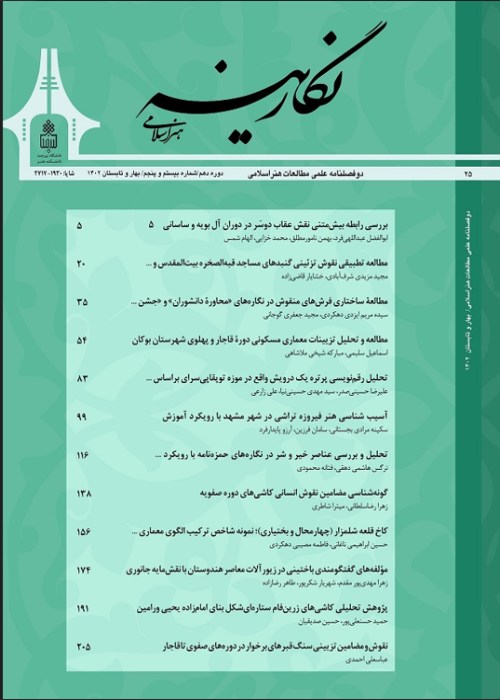Verbal Iconography of the Painter in Persian Literature (4th- 10th Centuries AH)
In Persian literature and poetry, the words painter and painting have been used many times and many writers and poets have used these words in their works. These words have been used descriptively and in the position of literary industries to describe the greatness and beauty of the creation of God or the Beloved, etc., and in some examples of Persian literature, the name of a particular painter is mentioned as the main character of the story and the painter is an influential character. The transition has become a process of literary narrative. The present article intends to study the painter's verbal iconography from the perspective of literature and literary narratives and while introducing the personality of the painter in these works, to study and describe their role, importance and place in the process of storytelling and narration. It should be noted that in this research, mainly mythical and fictional painters who do not necessarily have historical reality have been considered; Characters who are introduced as painters in prose and poetic literary works and have the profession and art of painting and are an actor and a fictional hero in the narrative. In this regard, the present article seeks to answer the question of what is the painter's verbal iconography in Persian literature and what painters have been described in Persian literature? The research method in the present study is descriptive-analytical and the method of collecting library information. In this research, Painters who have been introduced in the narratives and poems of poets and writers and have a key role in advancing the stories have also been studied. Findings of the research indicate that the painter and his imaginative creation have often been a source of inspiration for poets and Persian literature under various pretexts in the form of ima and reference to the image of the painter and even the name of a particular painter, and in some cases directly in the form of narrative Has designed the painter as one of the heroes of the narrative. In the literary examples studied in this research, we encountered the names of seven painters: Mani, Shapoor, Siavash, Khayal, Farhad, Shavor and Mehrab as key characters in the narratives. The painter in Persian literature is mostly from China, Rome and Iran, and the peak of the art of painting has been attributed to these countries. The painter is mainly a servant of the throne and is a shrewd and wise person, active and dynamic, world-seeing, resourceful, skillful and alert. He is very skilled and an artist in the art of painting, whose most important role is to introduce the lover of the story in narrative texts. It is to each other and in other texts it is the accompaniment of imagination and discovery of the beloved's face. In Persian literature, the painter is a kind of mediator of love, and since he is also the companion and advisor of the main characters, he causes carpentry with his expertise and solutions.
- حق عضویت دریافتی صرف حمایت از نشریات عضو و نگهداری، تکمیل و توسعه مگیران میشود.
- پرداخت حق اشتراک و دانلود مقالات اجازه بازنشر آن در سایر رسانههای چاپی و دیجیتال را به کاربر نمیدهد.



